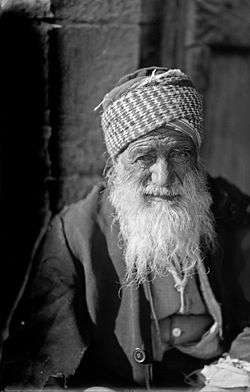Sudra (headdress)
Sudra (Aramaic: סודרא, Hebrew: סוּדָר) is a traditional ancient Jewish headdress, or what is also called a habit.

Etymology
The name sudra is Aramaic and derived from the Latin word sudarium, which means 'cloth' or 'handkerchief'.[1] However, according to the Babylonian Talmud, the word is a contraction of the phrase "Secrets are revealed to those who fear the Holy Name." [2]
History
The sudra is believed to be thousands of years old and referred to in the Bible. Ancient Hebrews wore a headgear that was similar to either a keffiyeh, turban or a stocking cap. There are many ways of tying the fabric to make these different designs.[3] The sudra has been mentioned directly and indirectly in ancient Jewish religious texts, including the Babylonian Talmud. Targum Ruth has interpreted different words in the Book of Ruth, such as mitpahat (הַמִּטְפַּחַת Ruth 3:15) mean the Sudra.[4] In Jewish tradition, the sudra was a twisted scarf worn around the neck[5] [6]There is also evidence of Jews wearing the sudra on their heads like a keffiyeh or turban in Tractate Berakhot, Tractate Kiddushin[7], and Tractate Shabbat [8] in the Babylonian Talmud.[9] Removing the Sudra to let another hold it was also seen as a sign of symbolic trust during a monetary deal.[10]
Decline
There are numerous reasons why sudras have fallen out of favour with modern Jews. According to Benny Katz of the Zionist Freedom Alliance (ZFA):
In ancient times, it was common for Jews to wear keffiyot, but the conquest of the region by Islamic tribes brought with it a series of laws that gave non-Muslims an inferior position in society. Synagogues could not be built higher than mosques and Jews could not ride atop animals for fear that they would appear higher than Muslims. As the keffiyeh came to be seen as the crown of the Arabs and its wearer was attributed an honorable status, non-Muslims were forbidden from wearing such garments.[11]
Amongst Ashkenazi Jewry, the Sudra quickly fell out of favour over time in favour of the streimel and the spodik, which was used as a means of humiliating Jews by forcing them to wear animals instead of cloth in the style of the Sudra.[12] Other more European style hats, such as the Borsalino came into favour[13] due to assimilation.
Zionist figures such as Rudy Rochman have publicly stated their desire to revive the Sudra as an act of decolonisation.[14] It is unclear how popular this effort has been.
References
- Wiktionary: סודרא
- Shabbat 77b
- J. R. Bartlett (19 July 1973). The First and Second Books of the Maccabees. CUP Archive. p. 246. ISBN 978-0-521-09749-9. Retrieved 17 April 2013.
traditional Jewish head-dress was either something like the Arab's Keffiyeh (a cotton square folded and wound around a head) or like a turban or stocking cap
- "Aramaic Targum to Ruth 3:15". www.sefaria.org. Retrieved 2020-06-24.
- Stammaim. Babylonian Talmud: Avodah Zarah. Babylonia. pp. 4a.
- Taanit 24a
- Kiddushin 29b
- Shabbat 77b
- "Tractate Berakhot 60B (Middle of the page)". Retrieved 2013-06-25.
- Bava Metzia 7a
- "PA Angered by Israeli Keffiyeh". Retrieved 2013-06-24.
- "Why Do Many Chassidim Wear Shtreimels (Fur Hats)? - And why doesn't Chabad wear them?". www.chabad.org. Retrieved 2020-08-07.
- "For Orthodox Jewish men, the hat known as a Borsalino is tops". Religion News Service. 2019-04-09. Retrieved 2020-08-07.
- "Rudy Rochman רודי רושמן". www.facebook.com. Retrieved 2020-08-07.
External links
- More References about a sudra on page 962 from Jastrow Dictionary Online
- the Sudra at Shemspeed